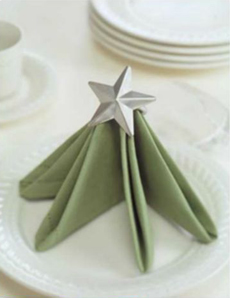TIP OF THE DAY: Christmas Tree & Star Of David Napkin Folds

|
Some people go all out decorating the holiday table: bowls of ornaments, candelabra, flowers, holly, miniature rosemary trees, pine boughs, pine cones, pomanders, reindeer, ribbons, the works. We always have so much food on the table that we need to keep things simple. We do it with a special tablecloth and napkins. And napkin folds. Last year we folded the dinner napkins in the shape of a traditional Christmas tree. This year, it’s a more abstract tree with a star. We found the top napkin fold on BHG.com, the website of Better Homes & Gardens. BHG has topped it with a star-shaped napkin ring. We don’t have star-shaped rings, but have jeweled gold-tone rings that will do the trick…unless we can pick up star rings on sale a day or two before Christmas. See how to fold the napkin, including a video, at BHG.com. If you don’t want a tree, FabArtDIY.com has collected 20 different holiday folds. Chinet has a nice collection, including a poinsettia and a double star. There are also year-round designs. We like how NancyCreative.com folds napkins into festive bows. Elf hats, anyone? Here’s a video from Good Housekeeping. Celebrating Chanukah? Here’s a Star of David. Star of David napkin fold (photo above). If you think you can do it, try this Star Of David, based on origami techniques. |
|
|
WHO ORIGINATED NAPKIN FOLDING? The art of napkin folding is called napery. The word comes from the Old French naperie, tablecloth. Not surprisingly, it started with royalty. According to one source, the art dates back to the around 1400, a time when warm napkins or even perfumed napkins graced the tables of the elite. Another source credits the reign of Louis XIV, 1643-1715. The craft trickled down to the homes of the wealthy and almost-wealthy (the upper middle class). At fine tables in the 19th century, starched napkins were artfully folded nightly. The use of napkin rings began in Europe during the Napoleonic era, 1799 to 1815. They were developed not for royalty, but for the bourgeoisie (middle class). The wealthy could afford freshly-laundered napkins at every meal; but the bourgeoisie lacked the servant bandwidth to make that happen. As a result, one cloth napkin would be used for all the meals in one day, or even for an entire week. Monogrammed napkin rings identified whom each napkin belonged to. In modern times, napkin rings have become decorative, and using them is much quicker than napery. Interested in the craft? Get a book on napkin folding and go to town! Gearing up for Valentine’s Day, the cover photo of the linked book is a pink napkin in a heart-shape fold. |
||



